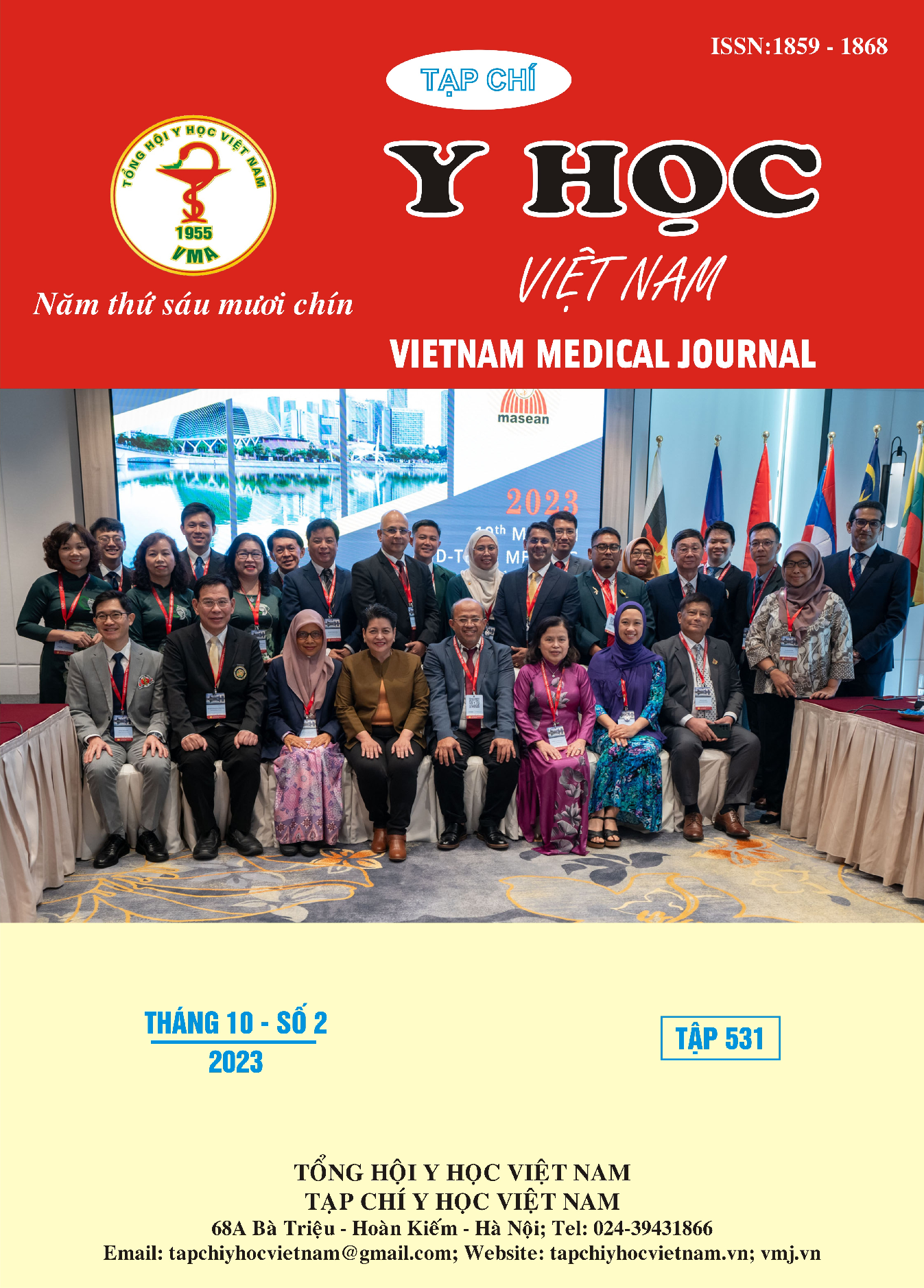EVALUATION OF CANCER RISK OF PIRADS 5 NODULES OF THE PROSTATE TRANSITION ZONE ACCORDING TO THE PI-RADS V2.1 CLASSIFICATION ON MAGNETIC RESONANCE IMAGING COMBINED WITH DENSITY PSA
Main Article Content
Abstract
Purpose: To evaluate the risk of cancer of PIRADS 5 nodules of the prostate transition zone according to the PI-RADS v2.1 classification on magnetic resonance imaging in combination with density PSA, with the results of prostate transrectal ultrasound guided biopsy as reference. Material and Methods: A retrospective descriptive study on 25 male patients at Hanoi Medical University Hospital from February 2019 to May 2022 due to high total PSA and/or urinary disorder. All patients underwent multiparameter magnetic resonance prostate imaging and transitional zone nodules classification according to PI-RADS v2.1. PIRADS 5 nodules will be biopsied under transrectal ultrasound guided then compared with histopathological results and combined with density PSA to assess the cancer risk of these nodules. Results: The mean age of the group of patients in the study was 68.2±9.1, the highest was 83 years old, the lowest was 53 years old. There are 05 patients without urinary disorders, accounting for 20%. The mean total PSA concentration in the group of patients was 46.5±33.6 ng/ml, the highest was 100 ng/ml, the lowest was 7 ng/ml. The mean prostate volume of the group of patients was 52.3±54.7 cm3, the highest was 308 cm3, the lowest was 22 cm3. The mean PSA density of the group of patients was 1.1±0.76 ng/ml/cm3, the highest was 2.63 ng/ml/cm3, the lowest was 0.09 ng/ml/cm3. There was 01 patient with PSA density < 0.10 ng/ml/cm3 and 01 patient with PSA density from 0.10-0.19 ng/ml/cm3, the rest PSA density ≥ 0.20 ng/ml/cm3. The results of prostate biopsy under transrectal ultrasound guided showed that 23/25 PIRADS 5 patients had cancer (92%, of which 02 patients GS=6; 12 patients GS=7; 06 patients GS=8 and 03 patients GS=9). The combination of PI-RADS v2.1 classification with PSA density was found in 2 patients with PIRADS 5 and PSA density <0.20 ng/ml/cm3, all of which were benign. All 23 patients with PIRADS 5 and PSA density ≥ 0.20 ng/ml/cm3 were all cancer. Conclusion: PI-RADS v2.1 classification on magnetic resonance imaging played an important role in screening for prostate cancer. For PIRADS 5 nodules of transition zone, the cancer rate is up to 92%. Combined with PSA density, with threshold ≥ 0.20ng/ml/cm3, all PIRADS 5 nodules of transition zones were cancer (accounting for 100%).
Article Details
Keywords
PI-RADS 5 nodules, prostate transition zone cancer, PSA density
References
2. Thai JN, Narayanan HA, George AK, et al. Validation of PI-RADS version 2 in transition zone lesions for the detection of prostate cancer. Radiology. 2018;288(2):485-491.
3. Satoshi Washino, Tomohisa Okochi, Kimitoshi Saito et al. Combination of prostate imaging reporting and data system (PI-RADS) score and prostate-specific antigen (PSA) density predicts biopsy outcome in prostate biopsy naıve patients. BJU Int 2017; 119: 225–233.
4. Marco Roscigno, Armando Stabile, Giovanni Lughezzani et al. The Use of Multiparametric Magnetic Resonance Imaging for Follow-up of Patients Included in Active Surveillance Protocol. Can PSA Density Discriminate Patients at Different Risk of Reclassification? linical Genitourinary Cancer Month 2020. https://doi.org/ 10.1016/j.clgc.2020.04.006.
5. Schoots and Padhani et al. Risk-adapted biopsy decision based on prostate magnetic resonance imaging and prostate-specific antigen density for enhanced biopsy avoidance in first prostate cancer diagnostic evaluation. BJU Int 2021; 127: 175–178 doi:10.1111/bju.15277.
6. Benson MC, Whang IS, Olsson CA, McMahon DJ, Cooner WH. The use of prostate specific antigen density to enhance the predictive value of intermediate levels of serum prostate specific antigen. The Journal of urology. 1992;147(3):817-821.
7. Castro HA, Iared W, Santos JEM, Solha RS, Shigueoka DC, Ajzen SA. Impact of PSA density of transition zone as a potential parameter in reducing the number of unnecessary prostate biopsies in patients with psa levels between 2.6 and 10.0 ng/mL. International braz j urol. 2018; 44:709-716.
8. Boesen L, Nørgaard N, Løgager V et al. Prebiopsy biparametric magnetic resonance imaging combined with prostate-specific antigen density in detecting and ruling out Gleason 7–10 prostate cancer in biopsy-naive men. Eur Urol Oncol 2019; 2: 311–9
9. van der Leest M, Cornel E, Israel B et al. Head-to-head comparison of transrectal ultrasound-guided prostate biopsy versus multiparametric prostate resonance imaging with subsequent magnetic resonance-guided biopsy in biopsy-naive men with elevated prostate-specific antigen: a large prospective multicenter clinical study. Eur Urol 2019; 75: 570–8
10. Knaapila J, Jambor I, Perez IM et al. Prebiopsy IMPROD biparametric magnetic resonance imaging combined with prostate specific antigen density in the diagnosis of prostate cancer: an external validation study. Eur Urol Oncol 2020; 3: 648–56.


